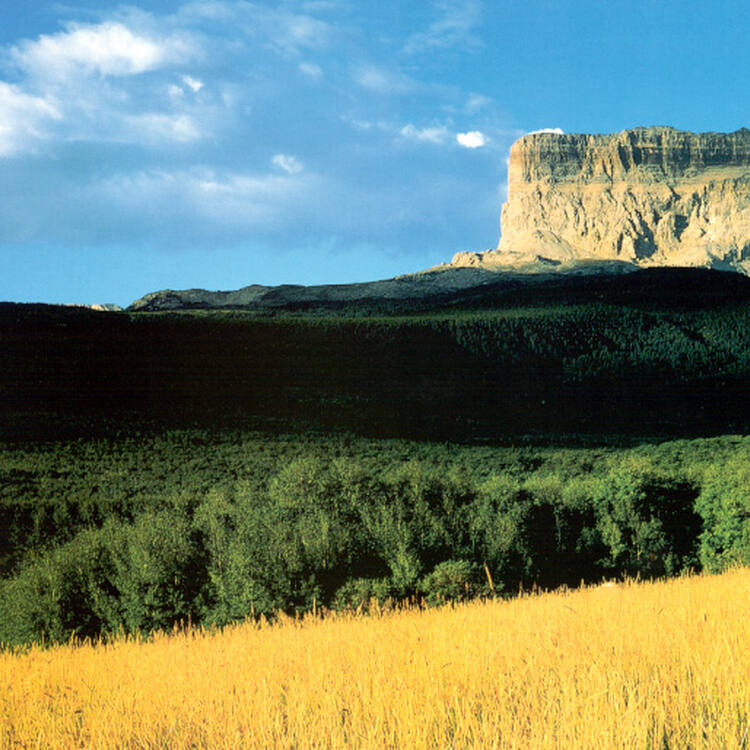Waterton Glacier International Peace Park
Waterton Glacier International Peace Park
In 1932 Waterton Lakes National Park (Alberta, Canada) was combined with the Glacier National Park (Montana, United States) to form the world's first International Peace Park. Situated on the border between the two countries and offering outstanding scenery, the park is exceptionally rich in plant and mammal species as well as prairie, forest, and alpine and glacial features.
Description is available under license CC-BY-SA IGO 3.0
Parc international de la paix Waterton-Glacier
En 1932, le parc national des Lacs-Waterton (Alberta, Canada) et le Glacier National Park (Montana, États-Unis d'Amérique) ont été réunis pour former le premier « parc international de la paix » du monde. Situé de part et d'autre de la frontière entre les deux pays, il offre des paysages d'une beauté exceptionnelle. Il est particulièrement riche en espèces végétales et en mammifères ainsi qu'en prairies, forêts, éléments alpins et glaciers.
Description is available under license CC-BY-SA IGO 3.0
الحديقة الدولية للسلام، حديقة واترتون-الكتل الجليدية
في العام 1932، جرى ضمّ الحديقة الوطنية للبحيرات-حديقة واترتون (في ولاية ألبرتا، في كندا) إلى الحديقة الوطنية للكتل الجليدية (في ولاية مونتانا، في الولايات المتحدة الأميركية) لتصبحا "الحديقة الدولية الأولى للسلام" في العالم التي تقع من جانبي الحدود الكندية-الأميركية، وتوّفر مناظر طبيعية رائعة الجمال. تزخر هذه الحديقة بالأجناس النباتية وبأصناف الثديات وكذلك بالمروج والغابات وعناصر البيئة الجبلية والكتل الجليدية.
source: UNESCO/CPE
Description is available under license CC-BY-SA IGO 3.0
沃特顿冰川国际和平公园
1932年,沃特顿湖区国家公园(加拿大艾伯塔省)与冰河国家公园(美国蒙大拿州)进行合并,组成世界上第一个国际和平公园。该公园位于加拿大和美国边界,风光迷人,特别是植物以及哺乳动物种类丰富,同时还拥有草原、森林、山地和冰川等地貌。
source: UNESCO/CPE
Description is available under license CC-BY-SA IGO 3.0
Международный Парк Мира Уотертон-Лейкс–Глейшер
В 1932 г. национальный парк Уотертон-Лейкс (провинция Альберта, Канада) был объединен с национальным парком Глейшер (штат Монтана, США), в результате чего был образован первый в мировой практике Международный Парк Мира. Располагающийся на стыке государственных границ двух стран, этот очень живописный парк, включающий участки прерий, лесов, альпийских и ледниковых высокогорий, обладает исключительно богатой флорой и фауной.
source: UNESCO/CPE
Description is available under license CC-BY-SA IGO 3.0
Parque Internacional de la Paz Waterton-Glacier
En 1932, el Parque Nacional de Waterton Lakes (Provincia de Alberta, Canadá) y el Parque Nacional de Glacier (Estado de Montana, EE.UU.) se fusionaron para formar “el primer parque internacional de la paz del mundo”. Situado a ambos lados de la frontera entre el Canadá y los Estados Unidos, este parque posee paisajes de excepcional belleza y una gran variedad de especies vegetales y mamíferos, así como praderas, bosques y formaciones geológicas alpinas y glaciares.
source: UNESCO/CPE
Description is available under license CC-BY-SA IGO 3.0
ウォータートン・グレーシャー国際平和自然公園
source: NFUAJ
Internationaal vredespark Waterton Glacier
Source: unesco.nl
Outstanding Universal Value
Brief synthesis
Waterton-Glacier International Peace Park has a distinctive climate, physiographic setting, mountain-prairie interface and tri-ocean hydrographical divide. It is an area of significant scenic values with abundant and diverse flora and fauna.
Criterion (vii): Both national parks were originally designated by their respective nations because of their superlative mountain scenery, their high topographic relief, glacial landforms and abundant diversity of wildlife and wildflowers.
Criterion (ix): The property occupies a pivotal position in the Western Cordillera of North America, resulting in the evolution of plant communities and ecological complexes that occur nowhere else in the world. Maritime weather systems unimpeded by mountain ranges to the north and south allow plants and animals characteristic of the Pacific Northwest to extend to and across the continental divide in the park. To the east, prairie communities nestle against the mountains with no intervening foothills, producing an interface of prairie, montane and alpine communities. The International Peace Park includes the headwaters of three major watersheds, which drain through significantly different biomes to different oceans. The biogeographical significance of this tri-ocean divide is increased by the many vegetated connections between the headwaters. The net effect is to create a unique assemblage and high diversity of flora and fauna concentrated in a small area.
Integrity
At 457,614 ha, the International Peace Park forms the centrepiece of the much larger transboundary “Crown of the Continent” ecosystem. The inscribed property alone is of sufficient size to maintain many of the scenic values and geomorphologic processes for which it was inscribed. Over 95% of the property is managed for wilderness values, but the property must be managed within the Crown of the Continent ecosystem context to ensure the genetic viability and long-term survival of many species, including top carnivores such as grizzly bear, cougar, gray wolf and wolverine, which may roam great distances outside the park boundaries. Likewise, the Flathead River system, which forms the western and southern boundaries of Glacier National Park and is home to important populations of fish species, originates outside the International Peace Park. Much of the property is bordered by other protected areas, adding important elements of connectivity for wildlife movement. While some barriers to connectivity within the larger ecosystem remain, there have been efforts by both countries to manage the Crown of the Continent to address these issues. These efforts will need to continue to ensure the long-term protection of the property’s Outstanding Universal Value.
Protection and management requirements
The two national parks are each managed and protected under their respective national legislative frameworks. Glacier National Park is managed under the authority of the Organic Act of August 25, 1916 which established the United States National Park Service. Glacier National Park also has enabling legislation which provides broad congressional direction regarding the primary purposes of the park. Waterton Lakes National Park is managed under the authority of the Canada National Parks Act and its associated regulations, which govern the protection and management of the natural and cultural resources of the park. Day-to-day management is directed by the Park Superintendent of each park according to the relevant legislative and regulatory mandates of the U.S. National Park Service and Parks Canada. The U.S. National Park Service and Parks Canada respectively maintain government to government relations with the Blackfeet Tribe as well as the Confederated Salish and Kootenai Tribes (Kootenai, Pend d’Oreille, and Salish Tribes) in the United States and the Blackfoot Confederacy (the Kainai, the Siksika, and the northern Piikani Nations) and the Ktunaxa Nation in Canada.
Management goals and objectives for the property have been developed through management plans for both parks, specifically: the Glacier National Park General Management Plan (1999) and the Waterton Lakes National Park of Canada Management Plan 2010. Although the management of each component of the property is directed by its own management plan, there are a number of guiding principles related to natural and cultural resource management, visitor use and interpretation, science and research and relations with Aboriginal peoples that are common to both parks, reflecting strong cooperation among the property managers. The management plans and their associated goals and objectives are periodically reviewed and updated with aboriginal, public, stakeholder and partner input, direction and advice.
A number of pressures arising from issues outside the Peace Park include residential, industrial and infrastructure development, and forestry practices in both countries. Park management plans for the property have identified a number of resource protection measures to address these pressures, such as environmental assessment processes, zoning, ecological integrity and visitor experience monitoring, as well as education programs.
In 2011, further to the Memorandum of Understanding on Environmental Protection, Climate Action and Energy signed by the Government of the Province of British Columbia and the Government of the State of Montana in 2010, British Columbia passed legislation to remove mining, oil and gas exploration and development as permissible land uses in the Flathead watershed in Canada thereby providing added environmental protection to the International Peace Park. The Crown Managers Partnership (a group of federal, state, provincial, tribal and first nations land managers) promotes transboundary collaborative strategies that focus on the long-term ecological health of the larger transboundary Crown of the Continent Ecosystem. In addition, the American Great Northern Landscape Conservation Cooperative provides additional opportunities for cooperation across jurisdictional and national boundaries.
Special attention will be given over the long term to monitoring and taking appropriate actions related to a number of factors in and near the property. Specifically, attention will focus on the effects of infrastructure development, the potential for water and air pollution, livestock grazing, impacts of biological resource use, impacts of climate change, and invasive or hyper-abundant species. Attention will also be given to current or potential logging and physical resource extraction activities near the property.
Links
-
Youtube - Glacier National Park
-
Tumblr - Glacier National Park
-
Flickr - Glacier National Park
-
Instagram - Glacier National Park
-
Twitter - Glacier National Park
-
Facebook - Glacier National Park
-
National Park Montana - National Park Service
-
Youtube - Parks Canada
-
Twitter - Waterton Lakes National Park, Parks Canada
-
Facebook page - Waterton Lakes National Park, Parks Canada
-
Waterton Lakes National Park
-
Protectedplanet.net


